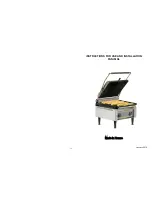
4
Chuck Removal
1. TURN OFF TOOL AND DISCONNECT FROM POWER SUPPLY.
2. Place chuck key in chuck as shown in Figure 5.
3. Using a wooden mallet or similar object, strike key sharply in a clockwise
direction. This will loosen screw inside chuck (Figure 5).
4. Open chuck jaws fully. Insert screwdriver (or 3/16" hex wrench if
required) into front of chuck between jaws to engage screw head.
5. Remove screw by turning clockwise (left-hand thread).
6. Place key in chuck as shown in Figure 6
7. Using a wooden mallet or similar object, strike key sharply in a counter-
clockwise direction. This will loosen chuck so that it can be unscrewed by
hand (Figure 6).
Drilling
1. Always turn off tool and disconnect from power supply when attaching or
changing bits or accessories.
2. Use sharp drill bits only. For WOOD, use twist drill bits, spade bits, power
auger bits, or hole saws. For METAL, use high speed steel twist drill bits
or hole saws. For MASONRY, such as brick, cement, cinder block, etc.,
use carbide-tipped bits
3. Be sure the material to be drilled is anchored or clamped firmly. If drilling
thin material, use a “back-up” block to prevent damage to the material.
4. Always apply pressure in a straight line with the bit. Use enough pressure
to keep the drill bit biting, but do not push hard enough to stall the motor
or deflect the bit.
5. Hold tool firmly to control the twisting action of the drill.
6. IF DRILL STALLS, it is usually because it is being overloaded. RELEASE
TRIGGER IMMEDIATELY, remove drill bit from work, and determine
cause of stalling. DO NOT CLICK TRIGGER OFF AND ON IN AN ATTEMPT
TO START A STALLED DRILL – THIS CAN DAMAGE THE DRILL.
7. To minimize stalling on breaking through the material, reduce pressure
on drill and ease the bit through the last fractional part of the hole.
8. Keep the motor running when pulling the bit back out of a drilled hole.
This will help prevent jamming.
9. With variable speed drills there is no need to center punch the point to be
drilled. Use a slow speed to start the hole and accelerate by squeezing the
trigger harder when the hole is deep enough to drill without the bit skip-
ping out. Operate at full speed after starting the bit.
Drilling in Wood
Holes in wood can be made with the same twist drills used for metal. These
bits may overheat unless pulled out frequently to clear chips from the flutes.
For larger holes, use spade bits, power auger bits, or hole saws. Work that is
likely to splinter should be backed up with a block of wood.
Figure 5
Figure 6
154569/1166-220 5/17/02 1:39 PM Page 4


























